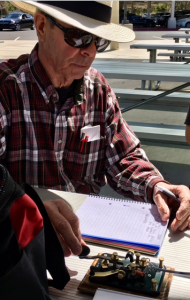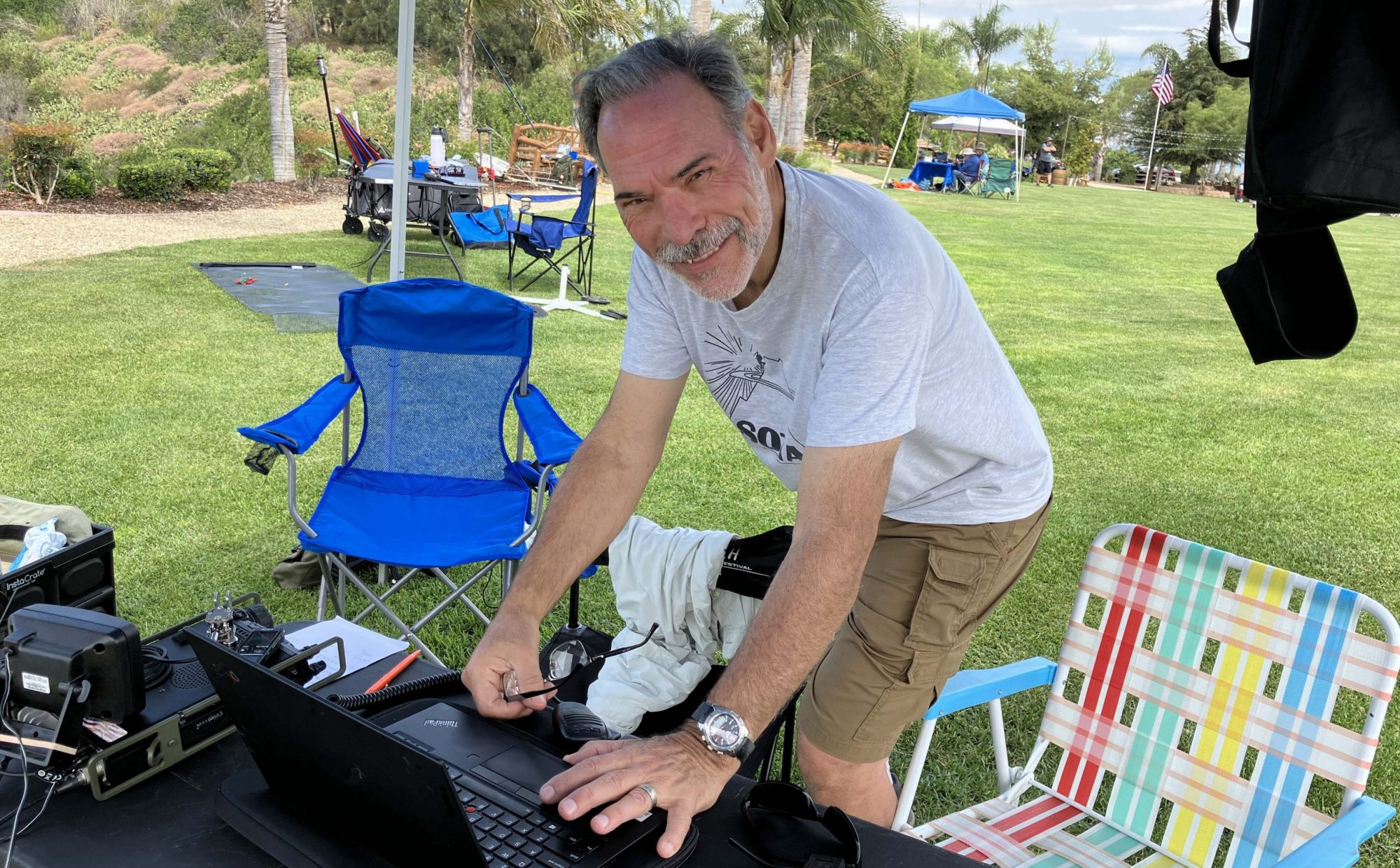By Norm Campbell-AB6ET
Setting Up Your Station—Make it Convenient
 As simple as it sounds, to get on the air you have to have your station set up and in place. And to make that happen it has to be convenient.
As simple as it sounds, to get on the air you have to have your station set up and in place. And to make that happen it has to be convenient.
Anyone can throw a lash up together and get on the air, but to stay on the air consistently your station has be in place and connected. Anything can work for a while, but if it starts taking more time to set up than it does to operate then radio turns into work. It doesn’t have to be totally permanent, but you have to have everything you need to get on the air.
Find a place where you set up that you can sit, write, and operate. Some hams are lucky enough to have a dedicated room. Others are under the stairs, in a cabinet, on a workbench, or in a corner. A desk, some shelves, or boards can work for you. What you want is to have a place where you can put your radio and accessories, as well as have a place for the mic, key, and earphones. Have a writing space with a bit of storage for paperwork and reference material, maybe a computer too. Look at various stations on the pages of QRZ.COM for ideas, or visit local hams to see what works for them.
Remember that you will need electrical connections for power supplies and accessories. Do you have some sockets nearby with the current capability you will need? How about heavy duty extension cords too? Leave some room behind the radios for all the electrical connections you’ll need. Think about tags on the wires so you know what goes to what the next time you add or disconnect something.
Nothing has to be solidly bolted down. After a while you might decide to move things around. You can make it even more convenient as you use it more frequently and find out what works best. Make it easy for yourself to get behind, move around, swap out, add, or subtract your equipment.
And make your antennas convenient too. Having your antennas up all the time and connected makes it much easier to get on the air. But antennas are not permanent either. Set them up with the idea that you can get to them again, take down, put up, experiment, and use.
Consider where you will bring in your antenna feedlines. There may be a few depending on what you plan to operate. Even if you only have one or two now, there may be more in the future so think about how you plan to bring them into the shack.
The beauty of radio is that no one can see it on the other end. So get your radio gear conveniently in place and start using it.
Don’t Buy—Diversify!
Face it, the HF bands stink. If you don’t operate much HF and hear that the bands are flat, you might be tempted to buy a new radio, amplifier, antenna, or special accessories thinking those things will make contacts for you.
If you have an HF radio and antenna and can get them on the air, then you probably have all you need. You can’t buy your way out of bad band conditions. You have to get on the air to make contacts. There are more than 800,000 licensed hams in the United States, 20,000 of which were just licensed in the last two years. Hams are out there and there are innovative ways to talk to them.
Even now, there are times when the bands cooperate and contacts can be  made easily. Other times when conditions are poor it takes diversity to make contacts. These are the days to try lots of things that you may not have used in the past. It’s a time to experiment with new bands, new modes, new times of day, and maybe new activities.
made easily. Other times when conditions are poor it takes diversity to make contacts. These are the days to try lots of things that you may not have used in the past. It’s a time to experiment with new bands, new modes, new times of day, and maybe new activities.
If you think you have to buy something, buy something that will give you the opportunity to work a new band or new mode. It’s also the time to thoroughly learn your radio and all its capability to squeak out the most performance from it. Develop skills that will make you a top notch radio operator.
Everyone should take advantage of the resources available to us. The internet is full of band condition monitors, spotting reports, beacons, reverse beacons, DX maps and the like. You can listen to the National Institute of Standards and Technology radio station WWV, regularly scheduled nets, and other frequencies known to have activity to find out if a band is open or where the propagation is.
This is also the time to learn the personality of each band, the time of day each should be more lively for certain types of activity, and the most likely frequencies to check.
But it takes getting on the air to make contacts. Listen, yes for sure, but also make calls. If everyone is listening then how do we know if anyone is there unless someone calls?
Not every contact is spontaneous, many are pre-arranged. You can call your local friends and suggest getting on the air. Set up a schedule when it’s convenient for you and a friend or friends to get on the air. Check-in to local nets and think about checking-in or joining nets around the country. Consider working community service events that guarantee radio activity.
There are other activities that are also known to create radio interest. How about modifying or building something and testing it with friends? Have you thought about contests, sprints, awards, and certificates? Remember that the club sponsors radio operating times too, such as picnics and Field Day.
Think about other ways to meet hams which can lead to making contacts. Consider being more active in the club by attending meetings and pre-meeting dinners, becoming an officer, or participating in committees and events. Talk to hams about eyeball-QSOs and meeting for coffee or other impromptu gatherings. These will lead to making arrangements to get on the air and to try something new or more regular with one another.
Don’t buy—diversify! You have a radio, use it. Now is the time to try anything and everything.
